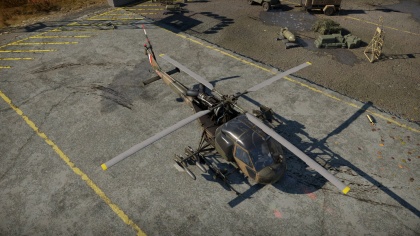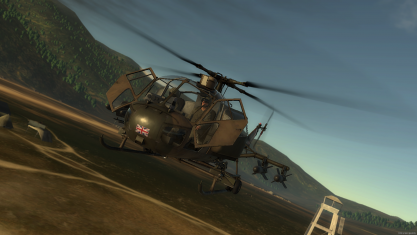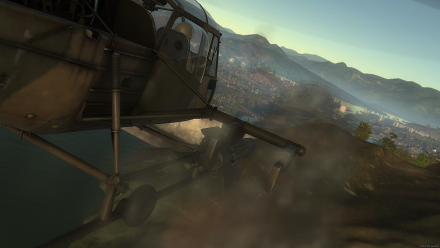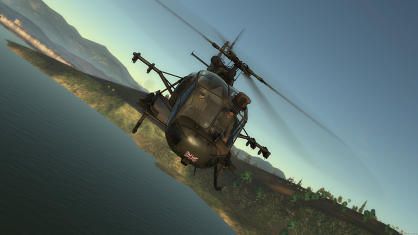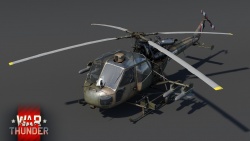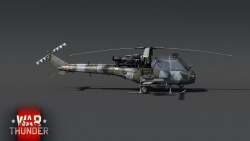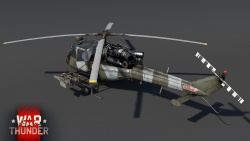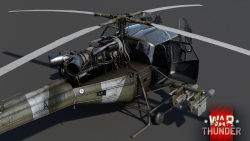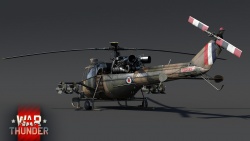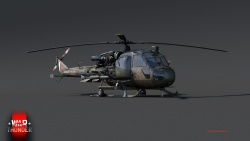Scout AH.Mk.1
Contents
| This page is about the British helicopter Scout AH.Mk.1. For other version, see Wasp HAS.Mk.1. |
Description
The Scout AH.Mk.1 is a rank V British helicopter
with a battle rating of 8.7 (AB/SB) and 8.3 (RB). It was introduced in Update 1.91 "Night Vision". It serves as opening helicopter for the British pilots that will familiarize with the helicopters game mechanics.
As a matter of facts, this is not a rookie friendly vehicle due to several vulnerabilities such as no armor, insufficient weaponry, and lacking countermeasures. It will require practice and tactics to get in sound with it and efficiently provide a good anti-tank close air support without being blown off the air by the anti-aircrafts.
On the other hand; it feels agile, fast, skillful, and packs a serious knock. Everything that represents the British helicopters down the line!
General info
Flight performance
The flight performance of the Scout will prove to be really satisfactory even when stock. It feels light, fast, and agile making it competent to dodge a lot of things that will rain at you, including tanks shells. Its speed and acceleration are sufficient to allow a good positioning when the match starts, setting the collider in 80%, and keeping a pitch of +2.0°/-4.0° will be usually enough for reaching a top speed without getting too much altitude or over-revving the propeller. Using the collider on 100% will increase the thrust (useful ascend is needed) but will reduce the horizontal speed drastically, making the helicopter prone to stalling on maneuvers.
When maneuvering to a different course keep in mind to don't lose speed, the proper way to do this is to lean the Scout for the desired direction then turning. That allows pilots to maintain the speed, indicated in the vectorial speed arrow at the center of your HUD.
The only payload to carry won't represent negatively in the performance. Using the hover mode and locking the target considerably improves the chance of an impact but it's feasible to also hit tanks when on the move, thanks to the great agility and stability.
| Characteristics | Max Speed (km/h at 1,000 m) |
Max altitude (metres) | |
|---|---|---|---|
| AB | RB | ||
| Stock | 196 | 186 | 5,400 |
| Upgraded | ___ | ___ | |
Survivability and armour
No armour
The Scout does not fly with any protecting armor or bullet-proof glass, which if installed would reduce Scout's ability to complete its mission. As such, the pilot must take this into account and fly the helicopter accordingly. Bull rushing right into the middle of a battlefield usually ends with disastrous results as, without armor, the Scout has nothing but thin metal fuselage coverings to protect the crew and vital equipment.
The pilot, gunner, engine, transmission, main rotor, and tail rotors are all exposed to fire from missiles, rockets, cannons, and even small-caliber machine guns. However, it's truly possible to survive several hits of a machine gun and making it to the heliport alive due to a slight spacing in all modules within the vehicle. The low speed of an incoming bullet sometimes it's just enough to damage the external hull but not pierce through.
The same cannot be stated from 20 mm cannons and beyond that will shred the helicopter piece by piece.
Higher survivability
The Flak jacket and Helicopter frame modules should be researched to increase the crew survivability against anti-air flak shells that are extremely dangerous to your helicopter and mostly for the crew. Pilots will see the improvement in this when attacked and manage to escape with minimal scars on their helo. A higher crew vitality (Pilot/Gunner) also improves the survival.
Armaments
Offensive armament
The Scout AH.Mk.1 is armed with:
- 2 x 7.62 mm L8A1 machine guns, skid-mounted (167 rpg = 501 total)
The L8 MGs are rather inaccurate when not ungraded. British pilots should not rely on this to attack any ground target as they mostly serve to defend against some air target that is pestering them or some other helo findable on their way to the enemy. A gun convergence of 600m is enough to fire efficiently without getting too close to the enemy.
Suspended armament
The Scout AH.Mk.1 can be outfitted with the following ordnance:
- 4 x AGM-22 missiles
The AGM-22 missiles are usually good and enough to end with a armored treat. Their SACLOS (Semi-automatic command to the line of sight) guidance requires keep aiming to the target til its impact. An advice is aim for the sides of the hull or turret as its possible in some tanks to survive one AGM impact; Therefore spending another on a single target. Keep in mind the limit range of 3 km and always predict the enemies movement to avoid an unsuccessful hit.
Usage in battles
As the Scout is such a weak target, the pilots must be aware of their surrounds and fight from the enemy vehicle's blind spots or weak sides, because a burning and crashed helicopter only pads the enemies' score-count. Analyze and choose your side to engage in battle and preserve the helicopter.
Pilots should consider not getting high altitude with this helicopter by several reasons:
- Vulnerable to enemy radars and AA missiles
- Jets will spot the Scout more easily and take it down
- Flight performance suffers and you lose all the advantages
- No cover and fully visible to anyone
Mixed battles
The best flight approach is low as conceivable to the ground. When the Scout can past trees, houses, and mountains remaining almost undetected. Try to don't go beyond the enemy's half of the map as it means a risk of getting detected and destroyed by AA based in the enemy spawn point or facing more deadlier enemy helicopters.
Instead, the Scout could support the allied offensive in its side of the map and from a safe low incognito place, launch the AGMs to enemy snipers that are decimating the allied advance or intruders capping a point. Then retreat to reload and repeat as required to ensure victory.
In a winning Medium/late match, opt for anti-Aircraft hunting as they mostly will focus on the proximity of the allied tanks advancing or allied jets streaming in the sky. If losing, pilots could look for a window and quickly cap a distant point consequently also help the team achieving victory and using the map to your advantage.
- In more empty or flat maps, it might be best to consider not using this helicopter and instead go for a plane. These types of maps will not provide any cover from enemy planes.
Modules
| Tier | Flight performance | Survivability | Weaponry | |
|---|---|---|---|---|
| I | Compressor | Flak jacket | ||
| II | Helicopter frame | New 7 mm MGs | ||
| III | Engine | Replacing helicopter blades | NVD | |
| IV | Cover | |||
Thanks to the great speed and agility, the main modules to be concern about are focused on protection and availability, such as the NVD or Flak jacket. The Assault mode can allow starting pilots to research the main modifications needed to improve the Scout to an optimal entry level for Mixed battles.
Pros and cons
Pros:
- Light and nimble helicopter. A skilled pilot is capable of dodging a lot of fire in this
- Small and stealthy profile. Among the smallest helicopters available.
- Perfect for Nap-of-the-earth (NoE) flying
- Decently speedy even when stock
- Powerful AGM-22 missiles. Capable to decimate most of the tank's frontal armor at the battle rating.
- Quite strong frame, often will be heavily damaged but remain on place.
Cons:
- Limited weaponry (only 4 AGMs) and defensive 2x 7.62 mm machine guns
- Exposed engine won't take a lot of damage before ceasing.
- No countermeasure for way better technologies in the battlefield
- Very vulnerable pilots and critical components due to no armor protection
- Painful grind to spade due to bad survivability
- Any other helicopter represents a threat (No armour protection and poor defense)
History
Development on the Westland Scout began in the late 1950s, however not at the Westland company, but at Saunders-Roe. Saunders-Roe developed their Saro P.531 light utility helicopter, which itself was based on the design of a previous piston-powered helicopter. The Saro P.531 already had several prototypes built and tested by the time the company was acquisitioned by Westland, who in turn, decided to continue development of the P.531.
As a result, in the early 1960s, the Westland Scout was created. The Scout conducted its maiden flight in August 1960 and was well-received with both the British Army and Royal Navy during testing. Following the favorable reception, the helicopter was subsequently ordered into production for the Army as the Scout AH Mk.1.
As work on the Scout steadily progressed, Westland continued developing a navalized version of the vehicle in parallel. The ‘Sea Scout’, as it was initially designated, only featured several minor design differences from the base model, such as a wheeled undercarriage and foldable blades and tail section, along with some other differences. After being reviewed by the Royal Navy, the ‘Wasp’ as it eventually became known, entered service with the Royal Navy in 1963, alongside the Army's Scout.
Both versions of the helicopter took part in combat operations during their service, most notably in Borneo, the Falklands and Northern Ireland. In the end, around 280 machines of both types were built, including export models.
- From Devblog
Media
- Images
See also
External links
| Westland Aircraft Limited | |
|---|---|
| Aircraft | |
| Fighters | Whirlwind Mk I · Whirlwind P.9 |
| Turboprop | Wyvern S4 |
| Helicopters* | |
| Attack | AH Mk.1 Apache** |
| Utility | Wessex HU Mk.5 · Scout AH.Mk.1 · Wasp HAS.Mk.1 · Lynx AH.Mk.1 · G-LYNX |
| *After World War II, Westland Aircraft focused on building helicopters and changed its name to Westland Helicopters. | |
| **Licensed AH-64D | |
| See Also | Boeing Aircraft |
| Britain helicopters | |
|---|---|
| Attack | AH Mk.1 Apache · Rooivalk Mk1F CSH · Superhind |
| Utility | Wessex HU Mk.5 · Scout AH.Mk.1 · Wasp HAS.Mk.1 · Lynx AH.Mk.1 · G-LYNX |



